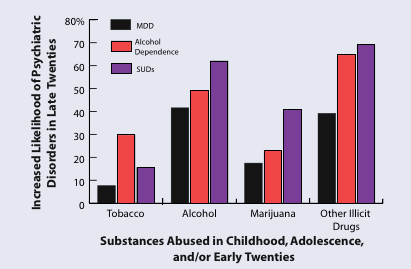 |

By Jill Schlabig Williams, NIDA NOTES Contributing Writer
One of the challenges of research into comorbidity--the co-occurrence of substance abuse and mental disorders--is determining the order in which these disorders occur and the factors that they share. Recent findings from a longitudinal study that followed more than 700 individuals from early childhood into their late twenties now confirms one sequence of events in the comorbidity conundrum.
Dr. Judith S. Brook and Dr. David W. Brook of New York's Mount Sinai School of Medicine and Dr. Patricia Cohen of Columbia University, also in New York, provide evidence that substance abuse significantly predicts the later occurrence of psychiatric disorders, including major depressive disorder (MDD), alcohol dependence, and substance use disorders (SUDs). Moreover, their findings suggest that there are common risk factors for both substance abuse and MDD and that once abuse begins, it becomes an additional risk factor for MDD.
| Early Substance Abuse Increases Likelihood of Developing Psychiatric Disorders in Late Twenties |
 Longitudinal study participants who abused tobacco, alcohol, marijuana, and other illicit substances in earlier years were more likely to have diagnoses of major depressive disorder (MDD), alcohol dependence, or substance use disorders (SUDs) in their
late twenties. |
|
"Most studies obtain data on psychiatric disorders and drug abuse simultaneously, so it's almost impossible to determine which came first," says Dr. Judith Brook. "This longitudinal data set is unique because it follows one group of people through their lives, collecting data roughly every 5 years on drug abuse patterns, psychiatric disorders, and other factors. This approach allows us to study the progression of drug abuse, how it affects a person's functioning, and how it relates to subsequent psychiatric disorders."
Researchers from the City University of New York randomly selected 736 survey participants in 1975 as part of an effort to identify the health needs
of children in Albany and Saratoga, New York. The ratio of boys to girls in the study reflected that of the population of children in both cities, as did the level of family intactness, family income, and parents' education level. The children were, on average, 6 years old when the study began.
Eight years later, Dr. Judith S. Brook and Dr. Cohen acquired the original data set and study population with support from NIDA and the National Institute of Mental Health (NIMH). Subsequent interviews were completed at approximately 5-year intervals. Participants were asked about tobacco, alcohol, marijuana, and other illicit drug abuse during each set of interviews, and psychiatric disorders were measured.
"Overall, alcohol and substance abuse during the early years was significantly related to later psychiatric disorders, even after we statistically controlled for age, sex, parents' education level, family income, and episodes of prior psychiatric symptoms," says Dr. Brook. "The cumulative frequency of substance abuse from childhood through early adulthood is strongly associated with episodes of MDD, alcohol dependence, and SUDs in the late twenties."
Earlier marijuana and tobacco use were each more strongly related to participants' development of MDD in their late twenties than more recent use of these substances. However, the opposite was true for alcohol use and other illicit drug use--recent use was more strongly related to development of MDD in the late twenties. The relationship between earlier use of all four substances--tobacco, alcohol, marijuana, and other illicit drug use--was more strongly related in every case to later alcohol dependence or SUDs than to later episodes of MDD.
Dr. Brook cites results related to marijuana use as a particularly key finding. Earlier marijuana use showed substantial effects on later incidence of MDD, alcohol dependence, and SUDs--17, 23, and 40 percent more likely, respectively. "Use of marijuana during childhood and adolescence should not be treated as benign, but rather may signal the later development of MDD, alcohol dependence, and SUDs," she says.
Treatment providers may benefit by considering the relationship between early substance abuse and later psychiatric disorders. "Well-coordinated interventions against the earliest use of drugs may alleviate the physiological and psychosocial problems that are related to adult psychiatric disorders," says Dr. David W. Brook.
Dr. Leslie Cooper of NIDA's Division of Epidemiology, Services and Prevention Research agrees that the findings in this study are significant. She cautions, however, that results must be interpreted carefully because the study sample is 92 percent white, with 93 percent of the participants having received at least a 12th-grade education. Although the sample is not representative of the general population, it was representative of the Northeast's population when the data were originally collected, she notes. "This longitudinal data set is extremely valuable because it allows us to track the relationship between early drug abuse and later psychiatric disorders," Dr. Cooper says. "But we can't generalize these results to other populations. We need to build on this study and gather information on other populations."
Dr. Brook will continue collecting data on this cohort every 5 years. "We will be able to watch these individuals as they move into their thirties and forties and see how earlier substance use affects their functioning at that age. We can also look at transmission across generations: How will the children of participants fare?"
Source
Brook, D.W.; Brook, J.S.; et al. Drug use and the risk of major depressive disorder, alcohol dependence, and substance use disorders. Archives of General Psychiatry 59(11):1039-1044, 2002.
[Abstract]
Volume 18, Number 5 (December 2003)
|
 |
|